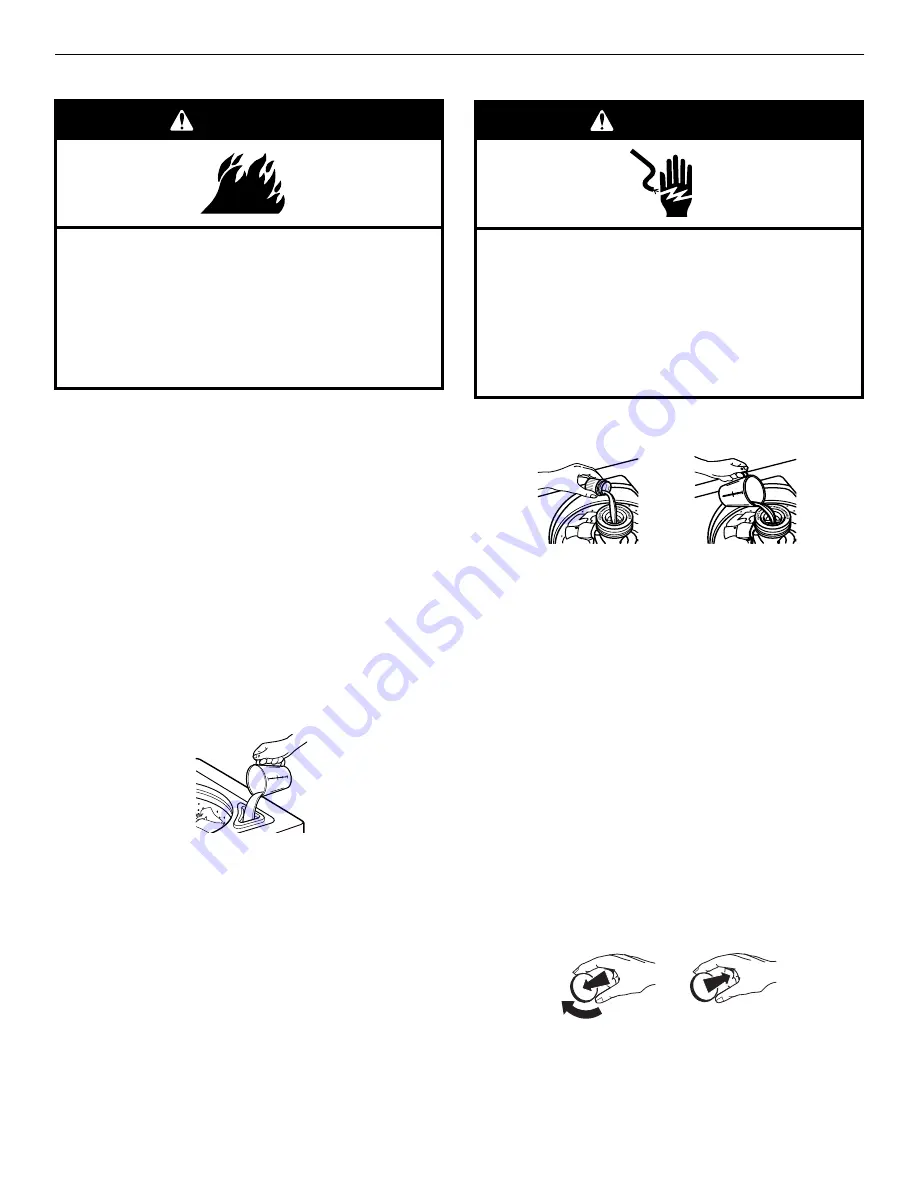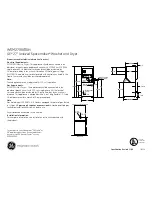
4
Starting Your Washer
1. Measure detergent and pour it into the washer. If desired, add
powdered or liquid color safe bleach. Drop a sorted load of
clothes loosely into your washer.
■
Load evenly to maintain washer balance. Mix large and
small items. Items should move easily through the wash
water. Overloading can cause poor cleaning.
2. (OPTIONAL) Add Liquid Chlorine Bleach.
NOTE: Follow the manufacturer’s directions for safe use.
Undiluted bleach will damage any fabric it touches. The
damage appears as rips, holes, tears, or color loss and may
not show up until several washings later. To avoid spilling, use
a cup with a pouring spout. Do not let bleach splash, drip, or
run down into the washer basket. Always measure liquid
chlorine bleach. Do not guess. Never use more than the
manufacturer’s recommended amount for a full load. Use less
with a smaller load size.
Style 1: With Chlorine Bleach Dispenser (on some models)
■
Use only liquid chlorine bleach in this dispenser. Pour
measured liquid chlorine bleach into the liquid chlorine
bleach dispenser. Bleach is immediately fed into washer and
is diluted automatically during the wash part of the cycle.
Style 2: Without Chlorine Bleach Dispenser (on some models)
■
Let the washer fill and begin agitating the load.
■
Add bleach 5 minutes into the wash cycle for best
cleaning and so that bleach can be removed in the rinse
cycle. Pour bleach around the agitator, not directly onto
the load.
3. (OPTIONAL) Add Liquid Fabric Softener.
NOTE: Do not spill or drip any fabric softener onto the
clothes. Undiluted fabric softener can stain fabrics. Always
dilute fabric softener with warm water. Too much fabric
softener can make some items (diapers and towels)
nonabsorbent. If this happens, do not use it every load, or
use less of it in each load.
Style 1: With Liquid Fabric Softener Dispenser (on some
models)
■
Use only liquid fabric softener in this dispenser. Pour
measured liquid fabric softener into the dispenser.
Softener is added automatically during the rinse portion
of the cycle. Dilute liquid fabric softener by filling the
dispenser with warm water until liquid reaches the
crossbar in the dispenser opening.
Style 2: Without Liquid Fabric Softener Dispenser (on some
models)
■
In the final rinse ONLY, add fabric softener that has been
diluted with
¹⁄₂
to 1 cup (125 to 250 mL) warm water.
4. Close the washer lid.
5. Turn the LOAD SIZE selector to the correct setting for your
wash load and the type of fabric being washed. You may
change the load size selection after the washer has started
filling by turning the selector to a different setting.
6. Set the TEMPERATURE selector to the correct setting for the
type of fabric and soils being washed. Use the warmest wash
water safe for fabric. Follow garment label instructions.
NOTE: In wash water temperatures colder than 70ºF (21ºC),
detergents do not dissolve well. Soils can be difficult to
remove. Some fabrics can retain wear wrinkles and have
increased pilling (the formation of small lint-like balls on the
surface of garments).
7. (OPTIONAL) EXTRA RINSE selector (on some models). For an
additional rinse and spin at the end of a wash cycle, set the
EXTRA RINSE selector to ON. On some models, the EXTRA
RINSE feature is part of the cycle.
8. Push in the Cycle Control knob and turn it clockwise to the
wash cycle you want. Reduce the wash time when using a
small load size setting. Pull out the Cycle Control knob to
start the washer.
To stop or restart your washer:
■
To stop the washer at any time, push in the Cycle
Control knob.
■
To restart the washer, close the lid (if open) and pull out
the Cycle Control knob.
Fire Hazard
Never place items in the washer that are dampened
with gasoline or other flammable fluids.
No washer can completely remove oil.
Do not dry anything that has ever had any type of oil on
it (including cooking oils).
Doing so can result in death, explosion, or fire.
WARNING
Electrical Shock Hazard
Plug into a grounded 3 prong outlet.
Do not remove ground prong.
Do not use an adapter.
Do not use an extension cord.
Failure to follow these instructions can result in death,
fire, or electrical shock.
WARNING





































